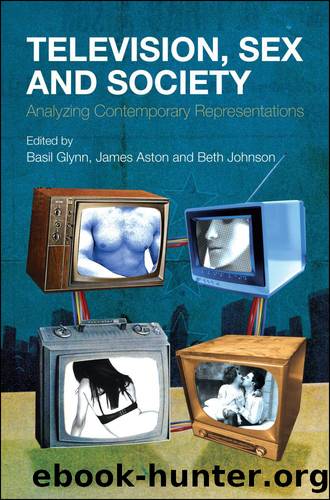Television, Sex and Society by Beth Johnson James Aston Basil Glynn

Author:Beth Johnson, James Aston, Basil Glynn [Beth Johnson, James Aston, Basil Glynn]
Language: eng
Format: epub
Tags: Nonfiction, Entertainment, Performing Arts, Television, Direction & Production, Social & Cultural Studies, Social Science
ISBN: 9781441141316
Publisher: Bloomsbury Publishing
Published: 2012-06-14T04:00:00+00:00
Conclusion
The notion of a lack of interactivity in watching pornography on television contradicts the aim of pornography which situates itself as a substitute for interaction with the ârealâ thing. As such it returns us back to Williamsâ âfrenzy of the visibleâ and the continual, but inaccessible, quest for authenticity and the ârealâ in representations of sexual intercourse. In the case of Television X the real is circumvented in favour of the artificial. That is, the production, content and reception of pornography on Television X resolutely returns the sex back to representation. Firstly, the restricted hardcore of the programmes deny viewers access to the ârealâ of sexual intercourse; secondly the action takes place away from visible spaces existing instead on topographical margins such as derelict warehouses, disused industrial factories and secluded rural locations; thirdly, the example of class in Television Xâs output, which forms a significant proportion of the schedule, delineates the woman as Other, as an ultimately unknowable figure relegated to symbol and stereotype and thus as a representational facsimile of the real; lastly, the technology of television acts as a screen rather than an interface further removing the viewer from the real in that they forgo choice and interactivity in favour of safety and regulated content decided by someone other than themselves.
The reverse directional flow of the real back to representation, which resists the advance of the âmainstreaming of sexâ on television that hardcore pornography has to an extent facilitated, can perhaps be framed as a confrontation between Luddites and Technophiles. This is not to say that advancements, such as the internet, should be considered in an anti-technological and anti-progressive manner, but that in the ever increasing quest for capturing the real and the authentic in representations of sex, boundaries between public and private, regulated and uncontrolled, safe and illicit have become porous and undefined. What Neil Postman (1993, p. 5), author of Technopoly astutely points out is that âpeople who are very enthusiastic about technology are always telling us what it will do for us. They almost never address the question of what it will undoâ. Therefore, Television Xâs undoing of the âfrenzy of the visibleâ and move back toward the secure domain of representation can be seen to address Luddite fears over technological innovation and the ramifications uncensored and limitless (internet) pornography can have on issues such as taste, identity and reception. Television Xâs antiquated and unsophisticated programming emphatically excludes a younger audience who are more likely to seek out unexpurgated hardcore pornography on the internet anyway, therefore suggesting that subscribers are older male viewers who have a longer standing connection to the television and are anxious about the seemingly infinite size of the internet, its unregulated and uncontrollable content and what consequences this may have for watching pornography. It is with this last point that ultimately situates Television X as a male orientated and phallocentric producer of pornography. Even though the restricted hardcore of the channel does afford some space for women to direct the action,
Download
This site does not store any files on its server. We only index and link to content provided by other sites. Please contact the content providers to delete copyright contents if any and email us, we'll remove relevant links or contents immediately.
Kathy Andrews Collection by Kathy Andrews(10519)
The remains of the day by Kazuo Ishiguro(7550)
Spare by Prince Harry The Duke of Sussex(4195)
Paper Towns by Green John(4169)
The Body: A Guide for Occupants by Bill Bryson(3798)
Be in a Treehouse by Pete Nelson(3211)
Harry Potter and the Goblet Of Fire by J.K. Rowling(3040)
Goodbye Paradise(2958)
Never by Ken Follett(2879)
Into Thin Air by Jon Krakauer(2700)
The Remains of the Day by Kazuo Ishiguro(2617)
The Genius of Japanese Carpentry by Azby Brown(2608)
The Cellar by Natasha Preston(2594)
Drawing Shortcuts: Developing Quick Drawing Skills Using Today's Technology by Leggitt Jim(2532)
120 Days of Sodom by Marquis de Sade(2435)
Architecture 101 by Nicole Bridge(2349)
The Man Who Died Twice by Richard Osman(2297)
Machine Learning at Scale with H2O by Gregory Keys | David Whiting(2285)
Fairy Tale by Stephen King(2063)
